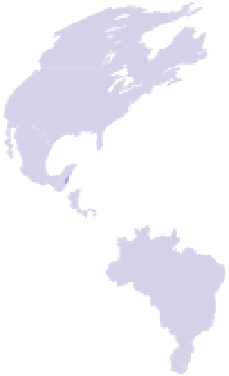Geoscience Reference
In-Depth Information
Consumption of proteins from fish
in % of total consumption of animal proteins
less than 10
20 to 30
10 to 20
more than 30
Figure 13.2
Consumption of proteins from i sh as a percentage of total world consumption of animal proteins. From UNEP/GRID-Arendal Maps and
Graphics Library. Retrieved 17 June 2010 from
http://maps.grida.no/go/graphic/i sh-protein-world-consumption.
increasing i shing pressure. World i sheries are rec-
ognized as being in decline, and despite equal or
increased i shing effort, improved detection tech-
nology, and growing demand, fewer i sh are being
caught than previously (Pauly
et al.
2005 ) and i sh
size is often smaller. With the global population
projected to rise to 9 billion by 2040 there will be
further demand for food production and provision
of protein from the sea. World i sheries already face
multiple challenges (Worm
et al.
2006 ), but are now
further subject to the twin stressors of climate
change and ocean acidii cation. Tropical coral reefs,
cold-water corals, and polar and upwelling ecosys-
tems are all important in supporting i sheries.
Recently they have all been highlighted as vulner-
able to ocean acidii cation on a timescale of a dec-
ade to several decades (Turley
et al.
2010a and
references within).
Attempts at estimating the economic impact of
ocean acidii cation for commercial i sheries have
been made for the USA (Cooley and Doney 2009),
the UK (Turley
et al.
2010b ), and the Mediterranean
Sea (Hilmi
et al.
2009 ). Commercial i sheries contrib-
uted $34 billion to the US gross national product in
2007, while in 2000 recreational marine i shing gen-
erated $12 billion of income in the USA and sup-
ported almost 350 000 jobs. Therefore loss of income
or jobs from reduced catch or loss of habitat or i sh-
ing grounds as a result of ocean acidii cation would
have signii cant economic impact. For example, loss
to i sheries from ocean acidii cation by 2060 has
been estimated to be 1.9 to 12.7% by value, depend-
ing on CO
2
emissions scenarios, based on integrated
net present values (Cooley and Doney 2009), but
other goods and services could be affected too
( Cooley
et al.
2009 ).
13.3.2 Carbon storage and regulation of gas
and climate
The oceans are an enormous store of carbon, sub-
stantially greater than storage on land or in the
atmosphere, and hence they play a key role in the
global carbon cycle, especially the regulation of
the amount of CO
2
in the atmosphere (Royal
Society 2005). The oceans have already taken up
around 28 to 34% of the CO
2
produced by human-
kind since the beginning of the Industrial
Revolution (Sabine
et al.
2004 ). This has reduced
the extent of global warming but has come at the






































































































